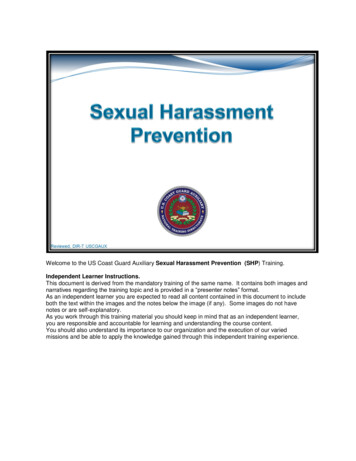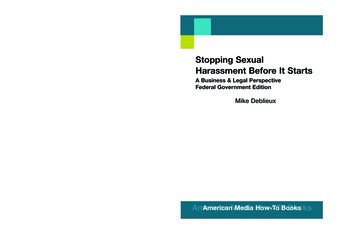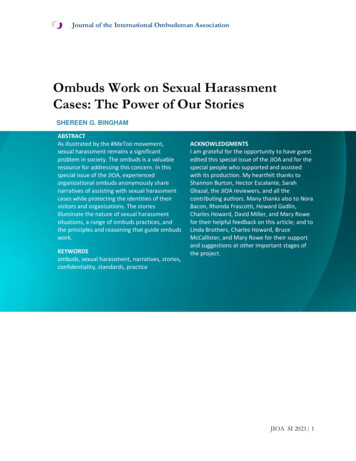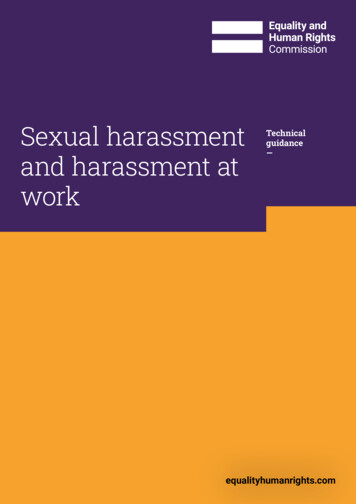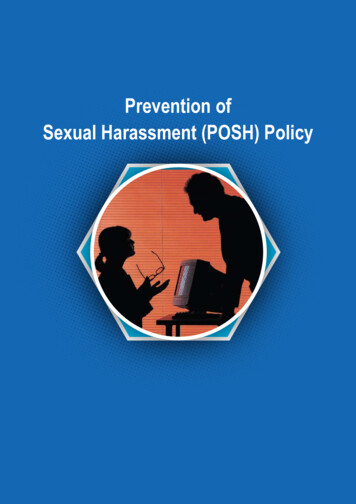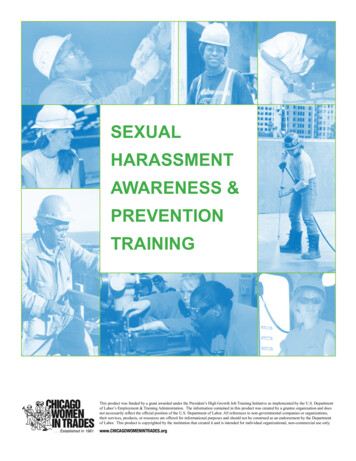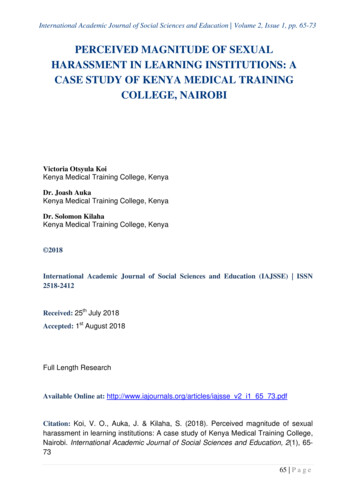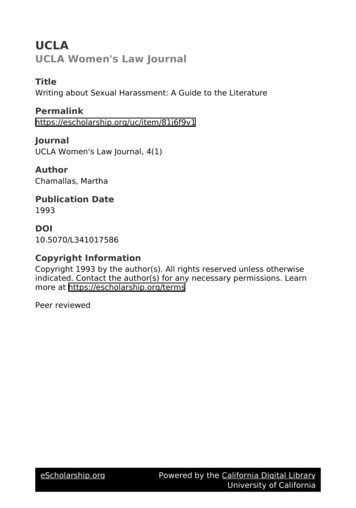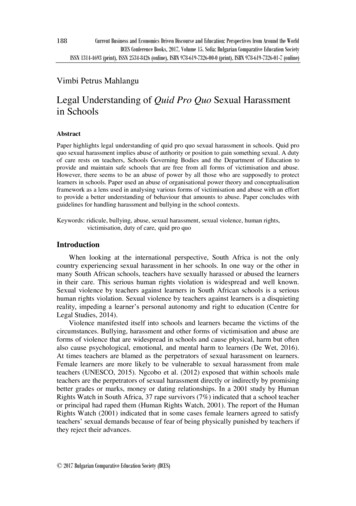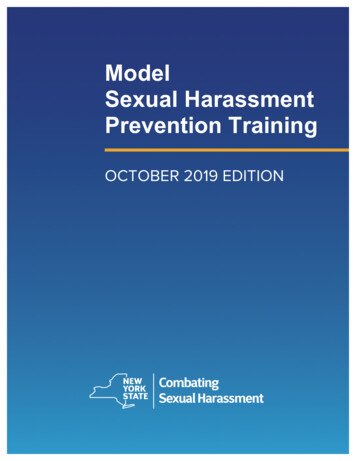
Transcription
ModelSexual HarassmentPrevention TrainingOCTOBER 2019 EDITIONSexual Harassment Prevention Training Page 1 10/19 Version
Purpose of this Model TrainingUnder the law, every employer in New York State is now required to establish a sexualharassment prevention policy pursuant to Section 201-g of the Labor Law. The Department ofLabor in consultation with the Division of Human Rights has established a model sexual harassmentprevention policy for employers to adopt, available at kplace. Or, employers may adopt a similar policy that meets or exceeds the minimumstandards of the model policy.In addition, every employer in New York State is now required to provide employees with sexualharassment prevention training pursuant to Section 201-g of the Labor Law. The Department ofLabor in consultation with the Division of Human Rights has established this model training foremployers to use. Or, employers may use a training program that meets or exceeds the minimumstandards of the model training.These documents must be provided to each employee (both at the time of hiring and during everysubsequent annual training) as part of a required notice.An employer’s sexual harassment prevention training must be interactive, meaning it requiressome level of feedback by those being trained.The training, which may be presented to employees individually or in groups; in person,via phone or online; via webinar or recorded presentation, should include as many of thefollowing elements as possible: Ask questions of employees as part of the program; Accommodate questions asked by employees, with answers provided in a timely manner; Require feedback from employees about the training and the materials presented.How to Use This TrainingThis model training is presented in a variety of formats, giving employers maximum flexibility todeliver the training across a variety of worksite settings, while still maintaining a core curriculum.Available training elements include:1.2.3.4.Script for in-person group training, available in PDF and editable Word formatsPowerPoint to accompany the script, available online and for download, also in PDFVideo presentation, viewable online and for downloadFAQs, available online to accompany the training, answering additional questions that ariseSexual Harassment Prevention Training Page 2 10/19 Version
Instructions for Employers This training is meant to be a model that can be used as is, or adapted to meet the specificneeds of each organization. Training may include additional interactive activities, including an opening activity, role playingor group discussion. If specific employer policies or practices differ from the content in this training, the trainingshould be modified to reflect those nuances, while still including all of the minimum elementsrequired by New York State law (shown on Page 4). The training should detail any internal process employees are encouraged to use to complainand include the contact information for the specific name(s) and office(s) with which employeesalleging harassment should file their complaints. It should also be modified to reflect the work of the organization by including, for example,industry specific scenarios. To every extent possible, this training should be given consistently (using the same deliverymethod) across each organization’s workforce to ensure understanding at every level and atevery location. It is every employer’s responsibility to ensure all employees are trained to employer’sstandards and familiar with the organization’s practices. All employees must complete sexual harassment prevention training at least once per year.This may be based on calendar year, anniversary of each employee’s start date or any otherdate the employer chooses. All new employees should complete sexual harassment prevention training as quickly aspossible. Employers must provide employees with training materials in English and in an employee’sprimary language if it is Spanish, Chinese, Korean, Polish, Russian, Haitian-Creole, Bengali, orItalian. Model templates are available online in these languages. For other languages,employers are strongly encouraged to provide materials in the language spoken by theemployee. On occasion, a participant may share a personal or confidential experience during the training.If this happens, the trainer should interrupt and recommend the story be discussed privatelyand with the appropriate office contact. After the training, follow up with this individual toensure they are aware of the proper reporting steps. Managers and supervisors must report allincidents of harassment.Sexual Harassment Prevention Training Page 3 10/19 Version
Minimum Training Standards ChecklistAn employer that does not use this model training -- developed by the State Department of Labor andState Division of Human Rights -- must ensure their training meets or exceeds the following minimumstandards.The training must: Be interactive; Include an explanation of sexual harassment consistent with guidance issued by theDepartment of Labor in consultation with the Division of Human Rights; Include examples of unlawful sexual harassment; Include information concerning the federal and state statutory provisions concerning sexualharassment and remedies available to targets of sexual harassment; Include information concerning employees’ rights of redress and all available forums foradjudicating complaints; and Include information addressing conduct by supervisors and additional responsibilities forsupervisors.Every employee must receive sexual harassment prevention training annually. During this annualtraining, employers must also provide employees a notice that contains:(i)the employer’s sexual harassment policy; and(ii)a copy of the information presented at the sexual harassment prevention training.Employers must provide employees with this notice, policy and training information in English and inan employee’s primary language if it is Spanish, Chinese, Korean, Polish, Russian, Haitian-Creole,Bengali, or Italian. Model templates are available online.Sexual Harassment Prevention Training Page 4 10/19 Version
NEW YORK STATESexual HarassmentPrevention TrainingELEMENT 1: TRAINING SCRIPTOCTOBER 2019 EDITIONSexual Harassment Prevention Training Page 5 10/19 Version
Table of ContentsTrainer Introduction .7Sexual Harassment in the Workplace .7What is Sexual Harassment? .8Hostile Environment .8Quid Pro Quo Sexual Harassment .9Who can be the Target of Sexual Harassment? .9Who can be the Perpetrator of Sexual Harassment? .10Where Can Workplace Sexual Harassment Occur? .10Sex Stereotyping .10Retaliation .11What is Retaliation? .11What is Not Retaliation .11The Supervisor's Responsibility .12Mandatory Reporting .12What Should I Do If I Am Harassed? .12What Should I Do If I Witness Sexual Harassment? .13Investigation and Corrective Action .14Investigation Process .14Additional Protections and Remedies.15New York State Division of Human Rights (DHR) .15United States Equal Employment Opportunity Commission (EEOC) .15Local Protections .15Other Types of Workplace Harassment .16Summary .16Sexual Harassment Case Studies .17Example 1: Not Taking “No” for an Answer .17Example 2: The Boss with a Bad Attitude .18Example 3: No Job for a Woman?.19Example 4: Too Close for Comfort .20Example 5: A Distasteful Trade .21Example 6: An Issue about Appearances .22Sexual Harassment Prevention Training Page 6 10/19 Version
Trainer Introduction Welcome to our annual training on sexual harassment prevention. My name is [name] and I am the [title] at [organization] . In recent years, the topic of sexual harassment in the workplace has been brought into thenational spotlight, bringing with it renewed awareness about the serious and unacceptablenature of these actions and the severe consequences that follow. The term “sexual harassment” may mean different things to different people, depending onyour life experience. Certain conduct may seem acceptable or have seemed acceptable in the past. That does notmean it is acceptable to the people we work with. The purpose of this training is to set forth a common understanding about what is and what isnot acceptable in our workplace.Sexual Harassment in the Workplace New York State has long been committed to ensuring that all individuals have an equalopportunity to enjoy a fair, safe and productive work environment. Laws and policies help ensure that diversity is respected and that everyone can enjoy theprivileges of working in New York State. Preventing sexual harassment is critical to our continued success. Sexual harassment will notbe tolerated. This means any harassing behavior will be investigated and the perpetrator or perpetrators willbe told to stop. It also means that disciplinary action may be taken, if appropriate. If the behavior is sufficientlyserious, disciplinary action may include termination. Repeated behavior, especially after an employee has been told to stop, is particularly seriousand will be dealt with accordingly. This interactive training will help you better understand what is considered sexual harassment. It will also show you how to report sexual harassment in our workplace, as well as your optionsfor reporting workplace sexual harassment to external state and federal agencies that enforceanti-discrimination laws. These reports will be taken seriously and promptly investigated, with effective remedial actiontaken where appropriate.Sexual Harassment Prevention Training Page 7 10/19 Version
What is Sexual Harassment? Sexual harassment is a form of sex discrimination and is unlawful under federal, state, and(where applicable) local law. Sexual harassment includes harassment on the basis of sex, sexual orientation, self-identifiedor perceived sex, gender expression, gender identity and the status of being transgender. Sexual harassment is unlawful when it subjects an individual to inferior terms, conditions, orprivileges of employment. Sexual harassment includes unwelcome conduct which is either of asexual nature, or which is directed at an individual because of that individual’s sex when:1. Such conduct has the purpose or effect of unreasonably interfering with an individual’swork performance or creating an intimidating, hostile or offensive work environment, even ifthe reporting individual is not the intended target of the sexual harassment;2. Such conduct is made either explicitly or implicitly a term or condition of employment; or3. Submission to or rejection of such conduct is used as the basis for employment decisionsaffecting an individual’s employment. Under New York State law, harassment need not be “severe or pervasive” to be unlawful. Anyof the harassing conduct described in this training can be unlawful unless it is shown to be nomore than “petty slights or trivial inconveniences.” There are two main types of sexual harassment:Hostile Environment A hostile environment on the basis of sex may be created by any action previously described,in addition to unwanted words, signs, jokes, pranks, intimidation, physical actions or violence,either of a sexual nature or not of a sexual nature, directed at an individual because of thatindividual’s sex. Hostile environment sexual harassment includes:o Sexual or discriminatory displays or publications anywhere in the workplace, such asdisplaying pictures, posters, calendars, graffiti, objects, promotional material, readingmaterials or other materials that are sexually demeaning or pornographic.!This includes such sexual displays on workplace computers or cell phones andsharing such displays while in the workplace.!This also includes sexually oriented gestures, noises, remarks, jokes orcomments about a person’s sexuality or sexual experience.o Hostile actions taken against an individual because of that individual’s sex, such as:!Rape, sexual battery, molestation or attempts to commit these assaults;Sexual Harassment Prevention Training Page 8 10/19 Version
!Physical acts of a sexual nature (including, but not limited to, touching, pinching,patting, grabbing, kissing, hugging, brushing against another employee’s body orpoking another employee’s body);!Interfering with, destroying or damaging a person’s workstation, tools orequipment, or otherwise interfering with the individual’s ability to perform the job;!Sabotaging an individual’s work;!Bullying, yelling, name-calling.Quid Pro Quo Sexual Harassment Quid pro quo sexual harassment occurs when a person in authority trades, or tries to trade, jobbenefits for sexual favors. Quid pro quo is a legal term meaning a trade. This type of harassment occurs between an employee and someone with authority, like asupervisor, who has the ability to grant or withhold job benefits. Quid pro quo sexual harassment includes:o Offering or granting better working conditions or opportunities in exchange for a sexualrelationshipo Threatening adverse working conditions (like demotions, shift alterations or worklocation changes) or denial of opportunities if a sexual relationship is refusedo Using pressure, threats or physical acts to force a sexual relationshipo Retaliating for refusing to engage in a sexual relationshipWho can be the Target of Sexual Harassment? Sexual harassment can occur between any individuals, regardless of their sex or gender. New York Law protects employees, paid or unpaid interns, and non-employees, includingindependent contractors, and those employed by companies contracting to provide services inthe workplace.Sexual Harassment Prevention Training Page 9 10/19 Version
Who can be the Perpetrator of Sexual Harassment? The perpetrator of sexual harassment can be anyone in the workplace: The harasser can be a coworker of the recipient The harasser can be a supervisor or manager The harasser can be any third-party, including: a non-employee, intern, vendor, buildingsecurity, client, customer or visitor.Where Can Workplace Sexual Harassment Occur? Harassment can occur whenever and wherever employees are fulfilling their workresponsibilities, including in the field, at any employer-sponsored event, trainings, conferencesopen to the public and office parties. Employee interactions during non-work hours, such as at a hotel while traveling or at eventsafter work can have an impact in the workplace. Locations off site and off-hour activities can be considered extensions of the workenvironment. Employees can be the target of sexual harassment through calls, texts, email and socialmedia. Harassing behavior that in any way affects the work environment is rightly the concern ofmanagement.Sex Stereotyping Sex stereotyping occurs when conduct or personality traits are considered inappropriate simplybecause they may not conform to other people's ideas or perceptions about how individuals ofeither sex should act or look. Harassing a person because that person does not conform to gender stereotypes as to“appropriate” looks, speech, personality, or lifestyle is sexual harassment. Harassment because someone is performing a job that is usually performed, or was performedin the past, mostly by persons of a different sex, is sex discrimination.Sexual Harassment Prevention Training Page 10 10/19 Version
Retaliation Any employee who has engaged in “protected activity” is protected by law from being retaliatedagainst because of that “protected activity.” “Protected activities” with regard to harassment include:o Making a complaint to a supervisor, manager or another person designated by youremployer to receive complaints about harassmento Making a report of suspected harassment, even if you are not the target of theharassmento Filing a formal complaint about harassmento Opposing discriminationo Assisting another employee who is complaining of harassmento Providing information during a workplace investigation of harassment, or testifying inconnection with a complaint of harassment filed with a government agency or in courtWhat is Retaliation? Retaliation is any action taken to alter an employee’s terms and conditions of employment(such as a demotion or harmful work schedule or location change) because that individualengaged in any of the above protected activities. Such individuals should expect to be freefrom any negative actions by supervisors, managers or the employer motivated by theseprotected activities. Retaliation can be any such adverse action taken by the employer against the employee, thatcould have the effect of discouraging a reasonable worker from making a complaint aboutharassment or discrimination. The negative action need not be job-related or occur in the workplace, and may occur after theend of employment, such as an unwarranted negative reference.What is Not Retaliation A negative employment action is not retaliatory merely because it occurs after the employeeengages in protected activity. Employees continue to be subject to all job requirements and disciplinary rules after havingengaged in such activity.Sexual Harassment Prevention Training Page 11 10/19 Version
The Supervisor's Responsibility Supervisors and managers are held to a high standard of behavior. This is because:o They are placed in a position of authority by the employer and must not abuse thatauthority.o Their actions can create liability for the employer without the employer having anyopportunity to correct the harassment.o They are required to report any harassment that is reported to them or which theyobserve.o They are responsible for any harassment or discrimination that they should have knownof with reasonable care and attention to the workplace for which they are responsible.o They are expected to model appropriate workplace behavior.Mandatory Reporting Supervisors must report any harassment that they observe or know of, even if no one isobjecting to the harassment. If a supervisor or manager receives a report of harassment, or is otherwise aware ofharassment, it must be promptly reported to the employer, without exception,o Even if the supervisor or manager thinks the conduct is trivialo Even if the harassed individual asks that it not be reported Supervisors and managers will be subject to discipline for failing to report suspected sexualharassment or otherwise knowingly allowing sexual harassment to continue. Supervisors and managers will also be subject to discipline for engaging in any retaliation.What Should I Do If I Am Harassed? We cannot stop harassment in the workplace unless management knows about theharassment. It is everyone’s responsibility. You are encouraged to report harassment to a supervisor, manager or other another persondesignated by your employer to receive complaints (as outlined in the sexual harassmentprevention policy) so the employer can take action. Behavior does not need to be a violation of law in order to be in violation of the policy.Sexual Harassment Prevention Training Page 12 10/19 Version
We will provide you with a complaint form to report harassment and file complaints, but if youare more comfortable reporting verbally or in another manner, we are still required to follow thesexual harassment prevention policy by investigating the claims. If you believe that you have been subjected to sexual harassment, you are encouraged tocomplete the Complaint Form and submit it to:o [Person or office designated]o [Contact information for designee or office]o [How the Complaint Form can be submitted] You may also make reports verbally. Once you submit this form or otherwise report harassment, our organization must follow itssexual harassment prevention policy and investigate any claims. You should report any behavior you experience or know about that is inappropriate, asdescribed in this training, without worrying about whether or not if it is unlawful harassment. Individuals who report or experience harassment should cooperate with management so a fulland fair investigation can be conducted and any necessary corrective action can be taken. If you report harassment to a manager or supervisor and receive an inappropriate response,such as being told to “just ignore it,” you may take your complaint to the next level as outlinedin our policy under “Legal Protections And External Remedies.” Finally, if you are not sure you want to pursue a complaint at the time of potential harassment,document the incident to ensure it stays fresh in your mind.What Should I Do If I Witness Sexual Harassment? Anyone who witnesses or becomes aware of potential instances of sexual harassment shouldreport it to a supervisor, manager or designee. It can be uncomfortable and scary, but it is important to tell coworkers "that's not okay" whenyou are uncomfortable about harassment happening in front of you. It is unlawful for an employer to retaliate against you for reporting suspected sexualharassment or assisting in any investigation.Sexual Harassment Prevention Training Page 13 10/19 Version
Investigation and Corrective Action Anyone who engages in sexual harassment or retaliation will be subject to remedial and/ordisciplinary action, up to and including termination. [Name of Company] will investigate all reports of harassment, whether information wasreported in verbal or written form. An investigation of any complaint should be commenced immediately and completed as soonas possible. The investigation will be kept confidential to the extent possible. Any employee may be required to cooperate as needed in an investigation of suspectedsexual harassment.o It is illegal for employees who participate in any investigation to be retaliated against.Investigation Process Our organization also has a duty to take appropriate steps to ensure that harassment will notoccur in the future. Here is how we will investigate claims. [Person or office designated] will conduct an immediate review of the allegations, and take anyinterim actions, as appropriate Relevant documents, emails or phone records will be requested, preserved and obtained. Interviews will be conducted with parties involved and witnesses Investigation is documented as outlined in the sexual harassment policy The individual who complained and the individual(s) accused of sexual harassment are notifiedof final determination and that appropriate administrative action has been taken.Sexual Harassment Prevention Training Page 14 10/19 Version
Additional Protections and Remedies In addition to what we’ve already outlined, employees may also choose to pursue outside legalremedies as suggested below. An individual is not required to make an internal complaint in order to pursue any of theseadditional outside options.New York State Division of Human Rights (DHR) A complaint alleging violation of the Human Rights Law may be filed either with DHR or in NewYork State Supreme Court. Complaints may be filed with DHR any time within one year (three years beginning Aug. 122020) of the alleged sexual harassment. You do not need to have an attorney to file. If an individual did not file at DHR, they can sue directly in state court under the Human RightsLaw, within three years of the alleged sexual harassment. An individual may not file with DHR if they have already filed a Human Rights Law complaint instate court. For more information, visit: www.dhr.ny.gov.United States Equal Employment Opportunity Commission (EEOC) An individual can file a complaint with the EEOC anytime within 300 days from the allegedsexual harassment. You do not need to have an attorney to file. A complaint must be filed with the EEOC before you can file in federal court. For more information, visit: www.eeoc.gov. NOTE: If an individual files an administrative complaint with DHR, DHR will automatically filethe complaint with the EEOC to preserve the right to proceed in federal court.Local Protections Many localities enforce laws protecting individuals from sexual harassment and discrimination. You should contact the county, city or town in which you live to find out if such a law exists. Harassment may constitute a crime if it involves things like physical touching, coerced physicalconfinement or coerced sex acts. You should also contact the local police department.Sexual Harassment Prevention Training Page 15 10/19 Version
Other Types of Workplace Harassment Workplace harassment can be based on other things and is not just about gender orinappropriate sexual behavior in the workplace. Any harassment or discrimination based on a protected characteristic is prohibited in theworkplace and may lead to disciplinary action against the perpetrator.o Protected characteristics include age, race, creed, color, national origin, sexualorientation, military status, sex, disability, marital status, domestic violence victim status,gender identity or expression, familial status, predisposing genetic characteristics andcriminal history. Much of the information presented in this training applies to all types of workplace harassment.Summary After this training, all employees are should understand what we have discussed, including:o How to recognize harassment as inappropriate workplace behavioro The nature of sexual harassmento That harassment because of any protected characteristic is prohibitedo The reasons why workplace harassment is employment discriminationo That all harassment should be reportedo That supervisors and managers have a special responsibility to report harassment. With this knowledge, all employees can achieve appropriate workplace behavior, avoiddisciplinary action, know their rights and feel secure that they are entitled to and can work in anatmosphere of respect for all people. Find the Complaint Form [insert information here]. For additional information, visit: ceSexual Harassment Prevention Training Page 16 10/19 Version
Sexual Harassment Case Studies Let’s take a look at a few scenarios that help explain the kind of behaviors that can constitutesexual harassment. Remember, it is up to all employees to report inappropriate behavior in the workplace. Please note that as an employee, it is not up to you to determine if something is sexualharassment and you should report anything you suspect may be sexual harassment. Amanager MUST report suspect sexual harassment.Example 1: Not Taking “No” for an AnswerLi Yan's coworker Ralph has just been through a divorce. He drops comments on a few occasionsthat he is lonely and needs to find a new girlfriend. Li Yan and Ralph have been friendly in the pastand have had lunch together in local restaurants on many occasions. Ralph asks Li Yan to go on adate with him—dinner and a movie. Li Yan likes Ralph and agrees to go out with him. She enjoys herdate with Ralph but decides
This model training is presented in a variety of formats, giving employers maximum flexibility to deliver the training across a variety of worksite settings, while still maintaining a core curriculum. Available training elements include: 1. Script for in-person group training, available in PDF and editable Word formats 2.


